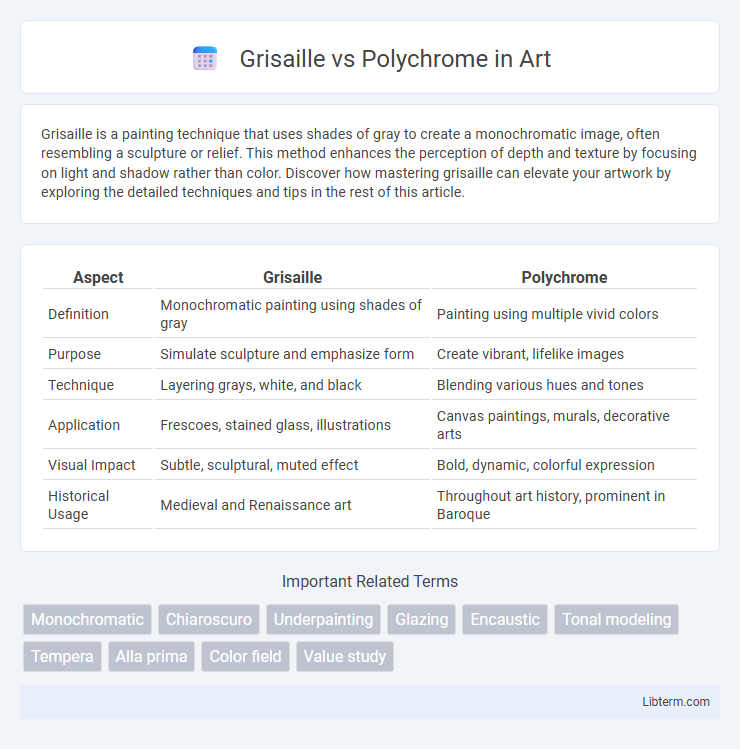Grisaille is a painting technique that uses shades of gray to create a monochromatic image, often resembling a sculpture or relief. This method enhances the perception of depth and texture by focusing on light and shadow rather than color. Discover how mastering grisaille can elevate your artwork by exploring the detailed techniques and tips in the rest of this article.
Table of Comparison
| Aspect | Grisaille | Polychrome |
|---|---|---|
| Definition | Monochromatic painting using shades of gray | Painting using multiple vivid colors |
| Purpose | Simulate sculpture and emphasize form | Create vibrant, lifelike images |
| Technique | Layering grays, white, and black | Blending various hues and tones |
| Application | Frescoes, stained glass, illustrations | Canvas paintings, murals, decorative arts |
| Visual Impact | Subtle, sculptural, muted effect | Bold, dynamic, colorful expression |
| Historical Usage | Medieval and Renaissance art | Throughout art history, prominent in Baroque |
Introduction to Grisaille and Polychrome
Grisaille is a monochromatic painting technique using shades of gray to create depth and volume, often employed in decorative art and manuscript illumination to mimic sculptural reliefs. Polychrome, in contrast, involves the use of multiple colors to bring vibrant and realistic visual effects, commonly applied in sculpture, ceramics, and panel paintings. Both techniques serve distinct artistic purposes: Grisaille emphasizes form and structure through tonal variation, while Polychrome highlights color and detail for a more lifelike representation.
Historical Origins of Grisaille
Grisaille originated in the early medieval period as a monochromatic painting technique using shades of gray to mimic sculpture, especially in stained glass and illuminated manuscripts. This method allowed artists to create depth and texture without relying on vibrant colors, emphasizing form and light. Polychrome, in contrast, emerged later with the development of more advanced pigment technology, incorporating multiple colors to enhance realism and decorative appeal.
Evolution of Polychrome Techniques
The evolution of polychrome techniques reveals a shift from the monochromatic Grisaille style, characterized by shades of gray to imitate sculpture, toward vibrant, multi-colored applications that enhanced realism and emotional depth in artworks. Innovations during the Renaissance introduced layered glazes and pigments that allowed for richer textures and intricate color variations, marking a significant advancement from the limited palette of Grisaille. This progression underscores the artistic transition from symbolic simplicity to expressive complexity, highlighting advancements in chemistry and material science that expanded artists' creative possibilities.
Key Differences: Grisaille vs Polychrome
Grisaille refers to a monochromatic painting technique using varying shades of gray to create the illusion of sculpture or three-dimensionality, often employed in underpainting or decorative art. Polychrome involves the application of multiple colors, enhancing realism and vibrancy through a diverse palette, commonly used in sculptures, stained glass, and traditional artworks. The key difference lies in Grisaille's emphasis on tonal values and minimal color for depth, while Polychrome prioritizes color variation to convey detail and life.
Artistic Purpose and Symbolism
Grisaille employs monochromatic shades of gray to mimic sculpture and emphasize form and volume, often symbolizing purity, simplicity, or spiritual introspection. Polychrome uses a vibrant color palette to convey emotional depth and realism, enhancing narrative richness and symbolizing life, vitality, or divine presence. Artists choose grisaille to evoke contemplation and timelessness, while polychrome communicates vivid storytelling and sensory engagement.
Materials and Methods Used
Grisaille painting employs monochromatic shades of gray or muted tones, traditionally executed using oil or tempera on canvas or panel to mimic sculptural relief. Polychrome techniques involve the application of multiple vivid colors, often using oil paints combined with gilding or varnishes on wood, stone, or metal surfaces to enhance realism and decorative effect. Grisaille methods emphasize layering tonal values to create depth without color, while polychrome relies on color blending and layering to achieve vibrant, lifelike imagery.
Notable Artists and Masterpieces
Grisaille, characterized by monochromatic gray tones simulating sculpture, features notable artists such as Jan van Eyck, whose Ghent Altarpiece includes grisaille panels, and Pieter Bruegel the Elder, known for his detailed grisaille drawings. Polychrome, distinguished by vibrant multi-colored painting, is exemplified by artists like Jean-Baptiste Carpeaux, who created the vivid polychrome sculpture "La Danse," and El Greco, whose dynamic use of color defines masterpieces such as "The Burial of the Count of Orgaz." Masterpieces in grisaille emphasize tonal subtlety and volumetric form, while polychrome works highlight rich color contrasts and expressive detail.
Grisaille and Polychrome in Modern Art
Grisaille, characterized by monochromatic gray tones, remains a powerful technique in modern art for emphasizing form, texture, and light without the distraction of color, often used to evoke a sense of timelessness or abstraction. Polychrome, involving the use of multiple vivid colors, dominates modern art practices for its ability to convey emotion, depth, and cultural symbolism dynamically. The contrast between grisaille's subtlety and polychrome's vibrancy highlights artists' deliberate choices in visual storytelling and conceptual expression in contemporary artworks.
Conservation and Restoration Challenges
Grisaille, a monochromatic painting technique using shades of gray, presents conservation challenges such as delicate tonal variations that are susceptible to fading and surface abrasion, requiring careful cleaning methods to avoid loss of depth. Polychrome artworks, characterized by multiple vivid colors, face complex restoration issues including pigment instability, color fading, and chemical reactions between layers that can cause cracking and peeling. Effective conservation strategies for both demand tailored approaches that consider the distinct material compositions and aging behaviors inherent to grisaille and polychrome media.
Choosing Between Grisaille and Polychrome in Contemporary Practice
Choosing between grisaille and polychrome in contemporary practice hinges on the desired visual impact and thematic expression; grisaille offers a monochromatic, sculptural effect emphasizing form and light, often suited for minimalist or architectural contexts. Polychrome enables a vibrant and dynamic use of color, enhancing emotional resonance and narrative complexity in artwork or design. Contemporary artists and designers weigh the subtleties of grayscale versus the vividness of color to align with their conceptual goals and audience engagement strategies.
Grisaille Infographic

 libterm.com
libterm.com